Are you tired of spending too much money on fabric softener? We have the perfect solution for you! Our homemade fabric softener is just pennies to make and requires only three ingredients, probably already in your home. So save some money and give your clothes a luxurious feel. Make your homemade fabric softener. Get the recipe today!
Introducing Homemade Fabric Softener!
Are you tired of scratchy, stiff clothes that lack that irresistible touch of softness? Look no further! Our delightful homemade fabric softener transforms your laundry experience and elevates your senses to new heights of comfort and freshness.
Naturally Gentle Ingredients: Our fabric softener is lovingly crafted using your hand-selected ingredients. Options abound! You can select a blend of botanical extracts and essential oils that nourish your fabrics while being gentle on sensitive skin or keep it unscented. Say goodbye to harsh chemicals and hello to a more eco-friendly laundry routine!
Unparalleled Softness: Experience the pure bliss of luxurious softness against your skin. Our homemade fabric softener leaves clothes velvety smooth, supple, and oh-so-touchable. Indulge in the sheer pleasure of cuddling up in clothes that feel like a warm embrace.
Irresistible Fragrances: Immerse yourself in a symphony of captivating scents that will awaken your senses. Our fabric softener allows you to add a range of enchanting fragrances, each carefully curated by you to add a touch of magic to your laundry. We love options like Lavender, Citrus, and more – each leaving a lingering aroma that will captivate everyone around you.
Long-Lasting Freshness: Bid farewell to stale odors that cling to your clothes even after washing. Our fabric softener infuses your fabrics with a long-lasting freshness that stays with you throughout the day. Embrace the confidence of knowing that you smell as fabulous as you feel!
Eco-Friendly Choice: We believe in making choices that are kind to you and the environment. Using our homemade fabric softener, you’re actively reducing your carbon footprint and contributing to a more sustainable future. Feel good about every load of laundry you do!
Easy to Use: Our fabric softener couldn’t be simpler to use. Just add during the rinse cycle, and voilà! Watch as your laundry is transformed into a paradise of softness and fragrance. Your clothes will thank you with every wear.

Get ready for the easiest homemade fabric softener recipe.
I’m sharing this DIY recipe for making your own liquid fabric softener. As a bonus, we’ve included recipes for homemade dryer sheets and copycat fabric softener crystals.
It’s the best homemade fabric softener recipe and is perfect for sensitive skin.
In my quest to stretch our budget, I shared a Homemade Laundry Detergent recipe for making your own laundry detergent, and now, adding to the laundry, this fabric softener. Scratchy clothes or static cling clothes aren’t anyone’s idea of comfortable. Miss M has sensitive skin that doesn’t tolerate too many chemicals. I am always seeking a way to keep her and the family comfortable.
This homemade fabric softener is easy to make and stores nicely.
It’s now a staple in my laundry room and added to every load of laundry.
I was surprised by how easy it is to make your own fabric softener with a hair conditioner. The higher quality or more expensive conditioners won’t make any noticeable differences, so don’t waste your money!
The overall effectiveness of this homemade fabric softener is very close to what regular commercial fabric softeners do.
When it comes to smell, the scent will depend on the conditioner. The scent’s strength will be determined by its power in the conditioner. Or skip the scented conditioner and use drops of your favorite essential oil for fragrance. I prefer a natural scent over artificial scents, but the fragrance is personal, so you do you!
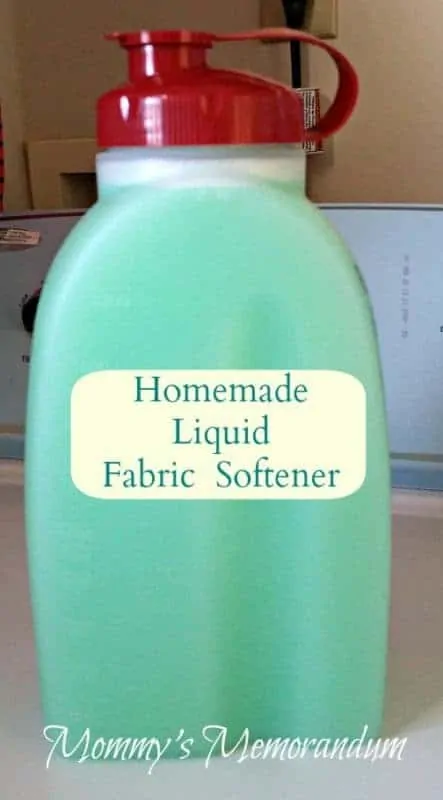
How Fabric Softener Works:
This homemade fabric softener, or any fabric softener, is to add to the washing machine during the rinse cycle to make clothes soft and feel better to the touch. It also helps reduce static cling. Fabric Softener works by depositing the lubricating agents on the fabric. The lubricating agents provide a layer of protection that seals in moisture and prevents static cling, which makes the fabric feel softer and more manageable. The coating agents also reduce friction, making fabric easier to iron and giving cloth garments a smoother, softer appearance. In this DIY fabric softener recipe, the conditioner and vinegar work together.
Fabric softeners work by depositing a thin layer of chemicals onto the surface of fabric fibers during the rinse cycle of the laundry process. These chemicals help smooth the fibers, reducing friction and making the fabric feel softer to the touch.
Here’s a breakdown of how fabric softeners work:
- Reducing Static: Fabric softeners contain positively charged molecules called cationic surfactants. These molecules are attracted to the negatively charged surface of fabrics, which helps neutralize static electricity. By reducing static cling, fabric softeners prevent clothes from sticking to each other and to your body.
- Lubricating Fibers: The cationic surfactants in fabric softeners also act as lubricants. They coat the fabric fibers, making them more slippery. This reduces the friction between the fibers, allowing them to glide over each other more easily. As a result, clothes feel smoother and more comfortable against the skin.
- Adding Fragrance: One of the appealing aspects of fabric softeners is the pleasant fragrance they impart to laundry. Softeners often contain fragrance or essential oils released as the fabric dries. The fragrance molecules attach to the fabric fibers, leaving a pleasant scent that lingers after storing the clothes.
It’s important to note that fabric softeners should be used according to the manufacturer’s instructions. Overusing fabric softener or using it on certain fabrics, such as towels or athletic wear, may reduce their absorbency or affect their performance. Always check the care labels on your garments to ensure compatibility with fabric softeners.
Homemade Fabric Softener
Not only does this homemade fabric softener work every bit, as well as the store-bought ones, but it’s also very affordable.
It is pennies to make and requires three ingredients, probably already in your home.
- Warm Water
- Conditioner
- Vinegar
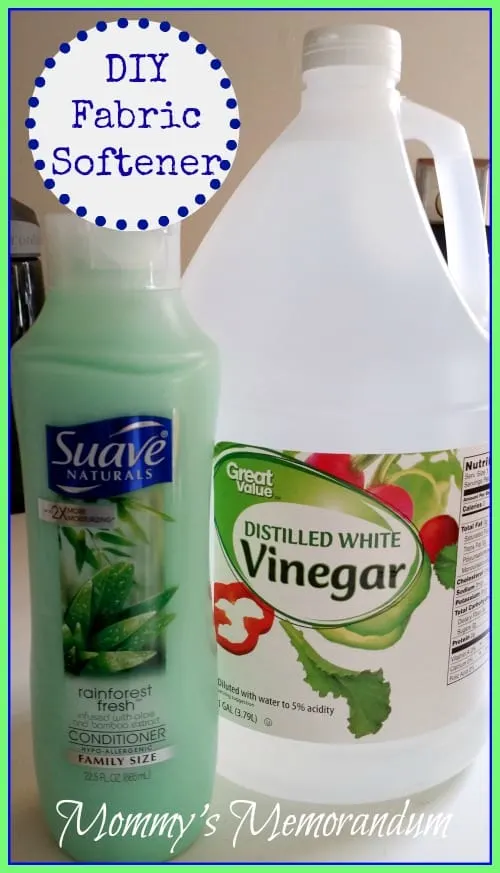
It was so easy, and the hardest part was boiling water!
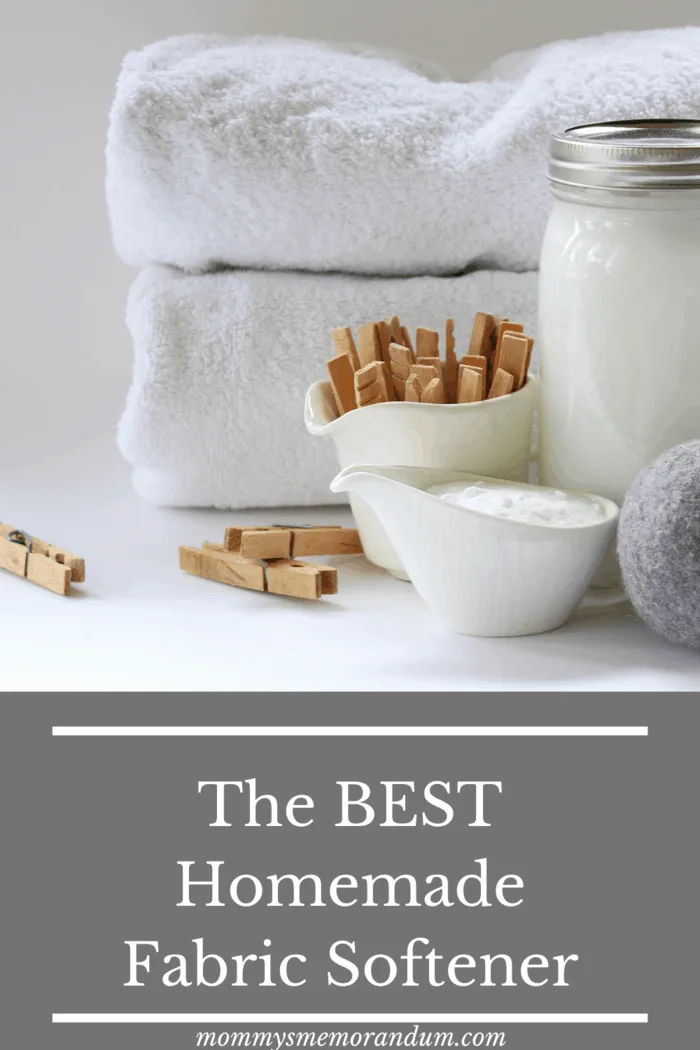
Homemade fabric softener ingredients
- 3 cups of vinegar (opt for white vinegar)
- 1 bottle of conditioner (I used the least expensive I could find)
- 6 cups of hot water
- a big bowl
- A storage container (it makes about 3 quarts)
- a few drops of essential oils (optional)
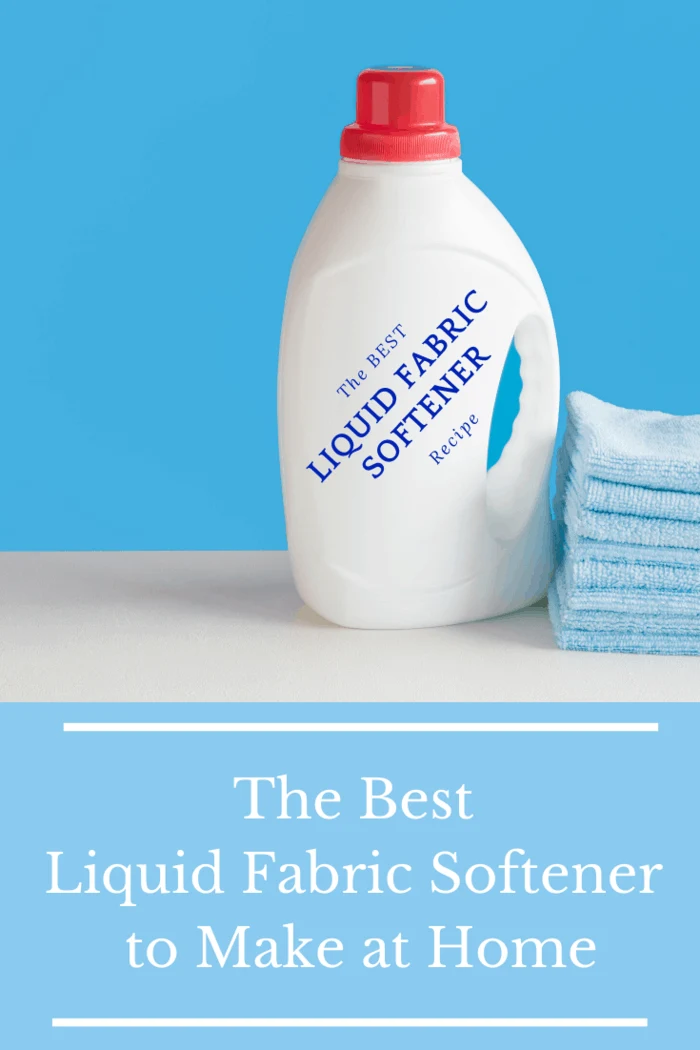
How to Make Your Own Homemade Fabric Softener Directions:
If you have hard water, I recommend using spring or distilled water.
Add the water and hair conditioner to a large mixing bowl or container and stir to combine until the conditioner is completely dissolved. (You don’t want to shake it; it will cause foaming.)
Add the vinegar and mix well.
Add a few drops of lavender essential oil or your favorite essential oil (optional).
Store in an airtight container–or spray bottle
How to Use:
Add 2 tablespoons per load directly into the fabric softener dispenser on your washer for smaller loads, or 1/4 cup for larger loads.
I use a Downy Ball ;)
Another great way to use this is to pour 1/4 cup of the fabric softener onto a clean washcloth, wring it to eliminate excess, and toss it in your dryer like a dryer sheet with your loads of laundry wash cycle!
NOTE: Vinegar will eventually wear out the elastic bands in your clothing.
Use sparingly or not at all with clothing items that contain elastic.
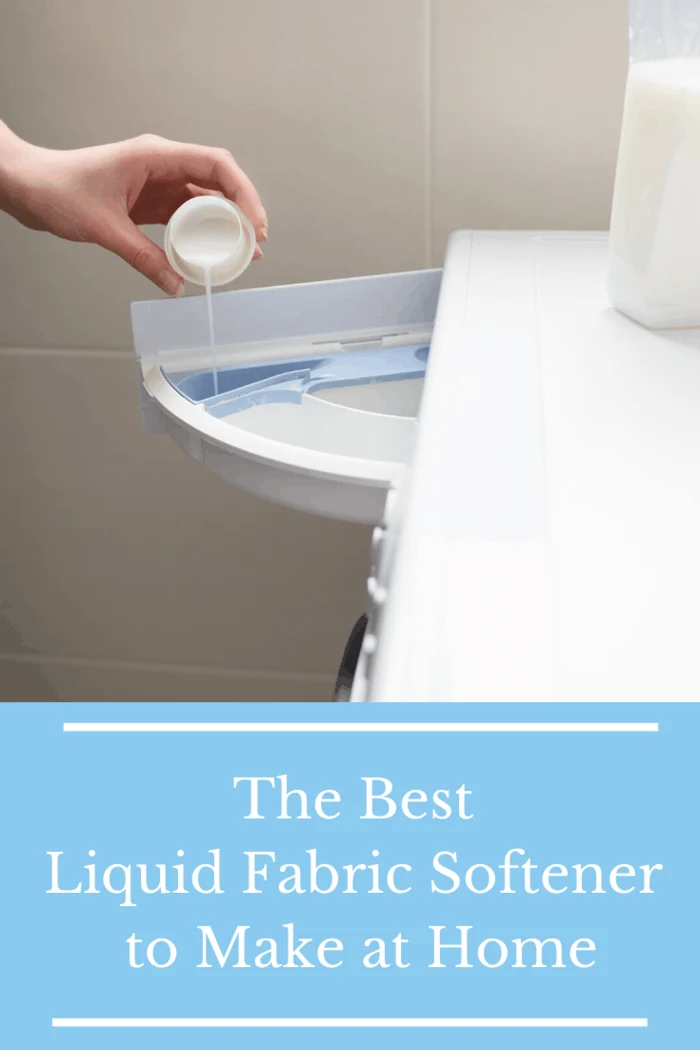
Homemade Fabric Softener-No Hair Conditioner Variation
You can leave the hair conditioner if you want a more organic liquid fabric softener.
Omit the hair conditioner with 5-10 drops of essential oil instead.
It works just as well. I prefer the version with hair conditioner.
This variation of homemade Fabric Softener follows.
Vinegar and Baking Soda as Fabric Softener (no conditioner version)
Vinegar and baking soda are popular natural alternatives to commercial fabric softeners. While they may not provide the same level of softness and fragrance as traditional fabric softeners, they offer some benefits and can be a more eco-friendly and cost-effective.
Here’s a closer look at vinegar and baking soda as fabric softeners:
- Vinegar as Fabric Softener: Vinegar, specifically white distilled vinegar, can be a fabric softener due to its acidic properties. Here’s how it works:
- Softening: Vinegar helps to break down residue and mineral deposits that can accumulate on fabric fibers, making them feel stiff. By removing these deposits, vinegar can restore the fabric’s natural softness.
- Reducing Odors: Vinegar is also effective in neutralizing and eliminating odors from clothes. It can help remove musty smells, cigarette smoke, and other unpleasant odors that may cling to fabrics.
- Removing Detergent Residue: Vinegar can act as a natural rinse aid, helping to remove detergent residue from clothes. This can result in fresher, cleaner garments.
To use vinegar as a fabric softener, add about half a cup of white distilled vinegar to the rinse cycle of your washing machine. It’s recommended to avoid using vinegar on delicate fabrics like silk or acetate, as it may cause damage.
- Baking Soda as Fabric Softener: Baking soda, or sodium bicarbonate, can be used as a natural fabric softener with some added benefits:
- Softening: Baking soda helps to relax the fibers in fabrics, making them feel softer and more comfortable against the skin.
- Neutralizing pH: Baking soda has a slightly alkaline nature, which can help balance the pH of the laundry water. This can be particularly useful if you have hard water, as it can counteract the effects of minerals that can make clothes stiff.
- Odor Control: Baking soda has deodorizing properties that can help eliminate odors from clothes. It can neutralize unpleasant smells and leave your laundry smelling fresh.
To use baking soda as a fabric softener, simply add half a cup to a cup of baking soda directly to the washing machine along with your detergent. It’s safe to use baking soda on most fabrics, but as with vinegar, it’s best to avoid delicate or sensitive fabrics.
Both vinegar and baking soda can be used in combination with each other or separately, depending on your preference. Experiment with different amounts to find the right balance for your laundry needs.
Remember to always check clothing labels for any specific instructions or restrictions regarding the use of vinegar or baking soda as fabric softeners.
Ingredients
6 cups vinegar
1 cup baking soda
15 drops essential oil (optional)
How to Make Vinegar and Baking Soda Fabric Softener
Pour the vinegar into a large bowl with essential oil if using.
Add the baking soda.
The mixture will fizz, when the fizz is minimized, pour into your storage container.
How to Use:
Shake vigorously before use.
Use up to 1 cup (depending on load size) per load.
Best Practices for Using Fabric Softener:
When it comes to laundry and fabric softener, there are certain items that you should avoid using fabric softener on.
Here are a few examples:
- Athletic Wear: Fabrics used in activewear, such as workout clothes, sports jerseys, and moisture-wicking fabrics, are designed to wick away sweat and moisture. Fabric softeners can leave a coating on these fabrics, reducing their ability to wick moisture and making them less effective in keeping you dry and comfortable during physical activities.
- Towels: Fabric softeners can decrease the absorbency of towels by leaving a residue on the fibers. This can make towels less effective at drying you off. To keep your towels fluffy and absorbent, it’s best to skip fabric softeners and opt for natural drying methods instead.
- Flame-Resistant Clothing: Fabric softeners can affect the flame-resistant properties of clothing made with flame-resistant materials, such as sleepwear or workwear. Using fabric softeners on these items may reduce their flame resistance, compromising their safety.
- Baby Clothes: Fabric softeners may contain fragrances and chemicals that can be harsh on a baby’s sensitive skin. It’s advisable to use fragrance-free, hypoallergenic detergents specifically formulated for baby clothes and skip fabric softeners altogether.
- Microfiber Fabrics: Microfiber materials, like microfiber towels or cleaning cloths, should not be treated with fabric softeners. Fabric softeners can leave a residue on microfiber surfaces, reducing their effectiveness in cleaning and absorbing.
- Water-Repellent Fabrics: Raincoats, outdoor gear, or waterproof jackets usually have a water-repellent coating. Fabric softeners can compromise the effectiveness of this coating, leading to reduced water repellency. It’s best to follow the care instructions provided by the manufacturer and avoid using fabric softeners on such items.
Always check the care labels on your garments for specific instructions regarding fabric softeners. When in doubt, it’s generally safe to skip fabric softeners for items that require special care or have specific performance properties.
Turn the Liquid Fabric Softener into Dryer Sheets!
Replace those commercial dryer sheets coated with harsh chemicals and make our own.
To turn liquid fabric softener into dryer sheets, you‘ll need some type of cloth material like an old T–shirt or a paper towel.
Cut fabric (cotton or flannel) into 5″x8″ strips. (or you can cut a clean sponge in half)
You can repurpose an old t-shirt or use wash cloths.
If you’re a sewer, stitch around the edge, but this is merely cosmetic and won’t affect the use.
Place fabric strips in liquid fabric softener and allow to soak.
Once they are completely saturated, let them air dry or place them in the dryer on low heat. When the dryer sheets are dry, they can be reused multiple times in the dryer.
You can also store tennis balls in a plastic container of natural fabric softener and then add them to your dryer.
How to Use Dryer Sheets:
Remove a fabric sheet from the jar and squeeze so it is not dripping.
Add a sheet to the dryer with wet laundry and dry it as usual.
Wool Dryer balls are also an excellent fabric softener.
We’ve Hacked the Recipe on Fabric Softening Crystals:
If you are a fan of Fabric Crystals for softening laundry, this easy recipe is for you.
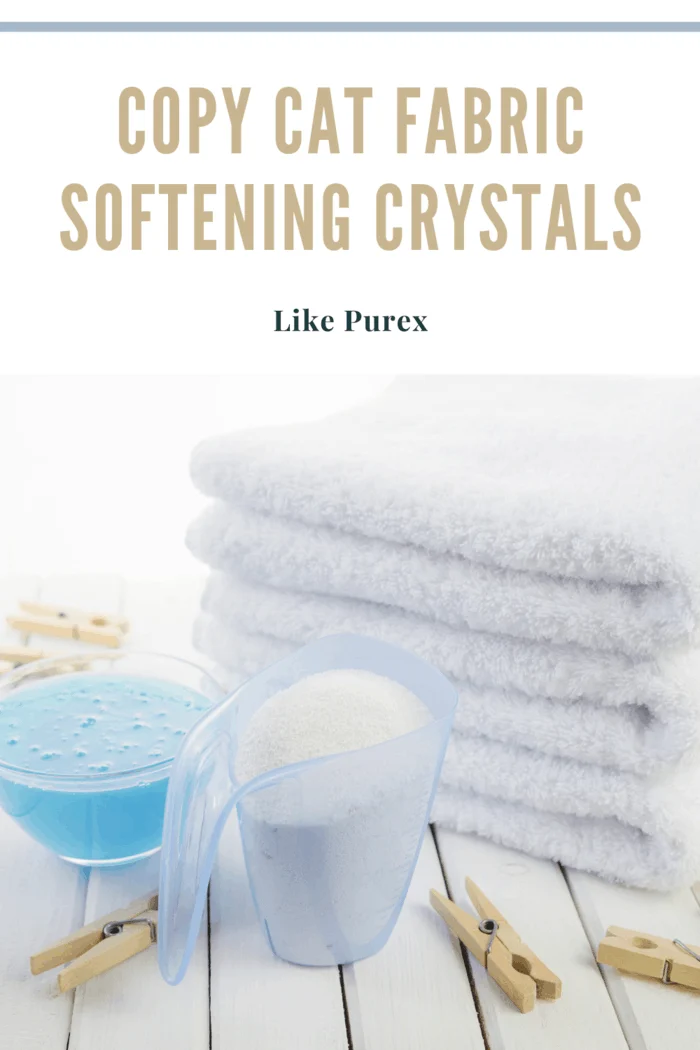
Recipe for Homemade Fabric Softener Crystals
It’s easy to make your own fabric softener crystals!
It’s another natural fabric softener alternative.
4 Cups Epsom Salts
40 drops Essential Oils
Mix the ingredients together and store them in an airtight container.
How to use:
To each wash add 1 or 2 Tablespoons of fabric crystals.
OR…the EASIEST
The easiest homemade fabric softener is using plain white vinegar in the final rinse.
Add 1/2 to 1 cup (depending on load size) of white vinegar to the last rinse in the washer. Vinegar is cheap and nontoxic, effective and antimicrobial. It WILL eventually wear out elastic.
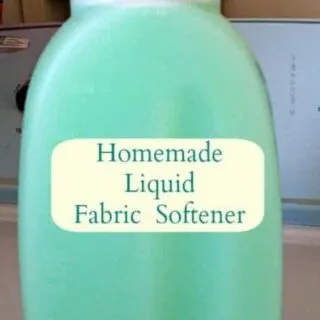
Make Your Own Homemade Fabric Softener
Learn how to make your own homemade fabric softener that's just pennies to make and requires three ingredients, probably already in your home.
Materials
- 3 cups of vinegar (opt for white vinegar)
- 1 bottle of conditioner (I used the least expensive I could find)
- 6 cups of hot water
- a big bowl
- A storage container (it makes about 3 quarts)
- a few drops of essential oils (optional)
Instructions
- If you have hard water, I recommend using spring water or distilled water.
- Add the water and hair conditioner to a large mixing bowl or container, and stir to combine until the conditioner is completely dissolved. (You don't want to shake it; it will cause foaming.)
- Add the vinegar and mix well.
- Add a few drops of lavender essential oil or your favorite essential oil (optional).
- Store in an airtight container--or spray bottle.
Notes
Add 2 tablespoons per load directly into the fabric softener dispenser on your washer for smaller loads, or 1/4 cup for larger loads.
I use a Downy Ball ;)
Another great way to use this is to pour 1/4 cup of the fabric softener onto a clean washcloth, wring it to eliminate exess, and toss it in your dryer like a dryer sheet with your loads of laundry wash cycle!

